Abstract
Secondary flow vortical patterns in arterial curvatures have the potential to affect several cardiovascular phenomena, e.g., progression of atherosclerosis by altering wall shear stresses, carotid atheromatous disease, thoracic aortic aneurysms and Marfan’s syndrome. Temporal characteristics of secondary flow structures vis-à-vis physiological (pulsatile) inflow waveform were explored by continuous wavelet transform (CWT) analysis of phase-locked, two-component, two-dimensional particle image velocimeter data. Measurements were made in a 180° curved artery test section upstream of the curvature and at the 90° cross-sectional plane. Streamwise, upstream flow rate measurements were analyzed using a one-dimensional antisymmetric wavelet. Cross-stream measurements at the 90° location of the curved artery revealed interesting multi-scale, multi-strength coherent secondary flow structures. An automated process for coherent structure detection and vortical feature quantification was applied to large ensembles of PIV data. Metrics such as the number of secondary flow structures, their sizes and strengths were generated at every discrete time instance of the physiological inflow waveform. An autonomous data post-processing method incorporating two-dimensional CWT for coherent structure detection was implemented. Loss of coherence in secondary flow structures during the systolic deceleration phase is observed in accordance with previous research. The algorithmic approach presented herein further elucidated the sensitivity and dependence of morphological changes in secondary flow structures on quasiperiodicity and magnitude of temporal gradients in physiological inflow conditions.










Similar content being viewed by others
References
Adlakha S, Sheikh M, Wu J, Burket MW, Pandya U, Colyer W, Eltawahy E, Cooper CJ (2010) Stent fracture in the coronary and peripheral arteries. J Interv Cardiol 23(4):411–419
Adrian RJ, Christensen KT, Li ZC (2000) Analysis and interpretation of instantaneous turbulent velocity fields. Exp Fluids 29:275–290
Alexopoulos D, Xanthopoulou I (2011) Coronary stent fracture: how frequent it is? does it matter? Hell J Cardiol 52:1–5
Berceli SA, Warty VS, Sheppeck RA, Mandarino WA, Tanksale SK, Borovetz HS (1990) Hemodynamics and low density lipoprotein metabolism. Rates of low density lipoprotein incorporation and degradation along medial and lateral walls of the rabbit aorto-iliac bifurcation. Arteriosclerosis 10:686–694
Bogren HG, Buonocore MH (1999) Complex flow patterns in the great vessels: a review. Int J Card Imagin 15:105–113
Bogren HG, Mohiaddin RH, Yang GZ, Kilner PJ, Firmin DN (1994) Magnetic resonance velocity vector mapping of blood flow in the thoracic aortic aneurysms and grafts. J Thorac Cardiovasc Surg 110(3):704–714
Bogren HG, Buonocore MH, Follette DM (2000) Four-dimensional aortic blood flow patterns in thoracic aortic grafts. J Cardiovasc Magn Reson 2(3):201–208
Boiron O, Deplano V, Pelissier R (2007) Experimental and numerical studies on the starting effect on the secondary flow in a bend. J Fluid Mech 574:109–129
Bulusu KV, Plesniak MW (2013) Secondary flow morphologies due to model stent-induced perturbations in a 180-degree curved tube during systolic deceleration. Exp Fluids 54(3):1493
Cecchi E, Giglioli C, Valentea S, Lazzeria C, Gensini GF, Abbate R, Mannini L (2011) Role of hemodynamic shear stress in cardiovascular disease. Atherosclerosis 214:249–256
Dai G, Kaazempur-Mofrad MR, Natarajan S, Zhang Y, Vaughn S, Blackman BR, Kamm RD, García-Cardeña G, Gimbrone MA Jr (2004) Distinct endothelial phenotypes evoked by arterial waveforms derived from atherosclerosis-susceptible and-resistant regions of human vasculature. PNAS 101(41):14,871–14,876
Dean WR (1927) Note on the motion of a fluid in a curved pipe. Phil Mag 7:208–223
Dean WR (1928) The streamline motion of a fluid in a curved pipe. Phil Mag 7:673–695
Deutsch S, Tarbell JM, Manning KB, Rosenberg G, Fontaine AA (2006) Experimental fluid mechanics of pulsatile artificial blood pumps. Annu Rev Fluid Mech 38:65–86
Eugene YK, Johnston RG (1996) The ineffectiveness of the correlation coefficient for image comparisons. Tech. Rep. LA-UR-96-2474, Los Alamos National Laboratory
Farge M, Guezennec Y, Ho CM, Meneveau C (1990) Continuous wavelet analysis of coherent structures. In: Center for turbulence research, proceedings of the summer program, pp 331–348
Friedman MH (2009) Variability of arterial wall shear stress, its dependence on vessel diameter and implications for murray’s law. Atherosclerosis 203:47–48. doi:10.1016/j.atherosclerosis.2008.07.003
Fung CC, Chung KP, Myers D (2001) Application of Hough transform for the identification of secondary flow patterns. In: Proc. IEEE region 10 international conference on electrical and electronic technology (TENCON), vol 2, pp 864–868
Fung YC (1996) Biomechanics: circulation, 2nd edn. Springer-Verlag, New York
Glenn AL (2011) Classification of secondary vortices in a curved pipe model of an artery. Master’s thesis, The George Washington University, Washington
Glenn AL, Bulusu KV, Shu F, Plesniak MW (2012) Secondary flow structures under stent-induced perturbations for cardiovascular flow in a curved artery model. Int J Heat Fluid Flow 35:76–83. doi:10.1016/j.ijheatfluidflow.2012.02.005
Gonzalez RC, Woods RE, Eddins SL (2003) Digital image processing using MATLAB. Prentice Hall, New Jersey
Hargreaves JC, Abe-Ouchi A (2003) Timing of ice-age terminations determined by wavelet methods. Paleooceanography 18(2):1035. doi:10.1029/2002PA000825
Himburg HA, Friedman MH (2006) Correspondence of low mean shear and high harmonic content in the porcine iliac arteries. Trans ASME. J Biomed Eng 128:852–856. doi:10.1115/1.2354211
Himburg HA, Grzybowski DM, Hazel AL, LaMack JA, Li X-M, Friedman MH (2004) Spatial comparison between wall shear stress measures and porcine arterial endothelial permeability. Am J Physiol Heart Circ Physiol 286:H1916–H1922
Himburg HA, Dowd SE, Friedman MH (2007) Frequency-dependent response of the vascular endothelium to pulsatile shear stress. Am J Physiol Heart Circ Physiol 293:H645–H653. doi:10.1152/ajpheart.01087.2006
Hoi Y, Zhou Y-Q, Zhang X, Henkelman RM, Steinman DA (2011) Correlation between local hemodynamics and lesion distribution in a novel aortic regurgitation murine model of atherosclerosis. Ann Biomed Eng 39:1414–1422. doi:10.1007/s10439-011-0255-z
Holdsworth D, Norley CJ, Frayne R, Steinman DA, Rutt BK (1999) Characterization of common carotid artery blood-flow waveforms in normal human subjects. Physiol Meas 20(3):219–240
Houston JG, Gandy SJ, Sheppard DG, Dick JB, Belch JJ, Stonebridge PA (2003) Two-dimensional flow quantitative MRI of aortic arch blood flow patterns: effect of age, sex, and presence of carotid atheromatous disease on prevalence of spiral blood flow. J Magn Reson Imaging 18:169–174
Houston JG, Gandy SJ, Milne W, Dick JB, Belch JJ, Stonebridge PA (2004) Spiral laminar flow in the abdominal aorta: a predictor of renal impairment deterioration in patients with renal artery stenosis? Nephrol Dial Transpl 19:1786–1791
Jarrahi M, Castelain C, Peerhossain H (2011) Secondary flow patterns and mixing in laminar pulsating flow through a curved pipe. Expe Fluids 50:1539–1558
Kailas SV, Narasimha R (1999) The eduction of structures from flow imagery using wavelets: Part i. The mixing layer. Exp Fluids 27:275–290
Karino T, Goldsmith HL, Motomiya M, Mabuchi S, Sohara Y (1987) Flow patterns in vessels of simple and complex geometries. Ann N Y Acad Sci 516:422–441
Kim SH, Kim HJ, Han SW, Jung SM, Kim JS, Chee HK, Ryu KH (2009) A fractured sirolimus-eluting stent with a coronary aneurysm. Ann Thorac Surg 88:664–665
Ku DN (1997) Blood flow in arteries. Annu Rev Fluid Mech 29:399–434
Lantz J, Karlsson M (2012) Large eddy simulation of LDL surface concentration in a subject specific human aorta. J Biomech 45:537–542
Lewalle J (1998) Three lectures on the application of wavelets to experimental data analysis. In: Breugelmans FAE (ed) von Karman institute lecture series on advanced measurement techniques, VKI LS 1998–06. The von Karman Institute for Fluid Dynamics, Belgium
Lewalle J, Peel FW, Murphy SJ (1995) Wavelet analysis of olfactory nerve response to stimulus. J Theor Biol 177:215–236
Lieber BB (2000) Arterial macrocirculatory hemodynamics. In: Bronzino JD (ed) The biomedical engineering hand book, vol 1, 2nd edn. CRC Press, Boca Raton
Lyne WH (1970) Unsteady flow in a curved pipe. J Fluid Mech 45:13–31
Malek AM, Alper SL, Izumo S (1999) Hemodynamic shear stress and its role in atherosclerosis. JAMA 282(21):2035–2042
Mallubhotla H, Belfort G, Edelstein WA, Early TA (2001) Dean vortex stability using magnetic resonance flow imaging and numerical analysis. AIChE J 47(5):1126–1139
Montanero JM, Ferrera C, Shevtsova VM (2008) Experimental study of the free surface deformation due to thermal convection in liquid bridges. Exp Fluids 45:1087–1101. doi:10.1007/s00348-008-0529-x
Nair RN, Quadros K (2011) Coronary stent fracture: a review of the literature. Card Cath Lab Dir 1:32–38
Neto AM (2007) Pearson’s correlation coefficient for discarding redundant information in real time autonomous navigation system. In: 16th IEEE international conference on control applications, part of IEEE multi-conference on systems and control, pp 426–431
Otsu N (1979) A threshold selection method from gray-level histograms. IEEE Trans Sys Man Cyber 9(1):62–66. doi:10.1109/TSMC.1979.4310076
Peterson SD, Plesniak MW (2008) The influence of inlet velocity profile and secondary flow on pulsatile flow in a model artery with stenosis. J Fluid Mech 616:263–301. doi:10.1017/S0022112008003625
Ponzini R, Vergara C, Rizzo G, Veneziani A, Roghi A, Vanzulli A, Parodi O, Redaelli A (2010) Womersley number-based estimates of blood flow rate in Doppler analysis: in vivo validation by means of phase-contrast MRI. IEEE Trans Biomed Eng 57(7):1807–1815
Popma JJ, Tiroch K, Almonacid A, Cohen S, Kandzari DE, Leon MB (2009) A qualitative and quantitative angiographic analysis of stent fracture late following sirolimus-eluting stent implantation. Am J Cardiol 103(7):923–929
Rindt CMM, van Steenhoven AA, Janssen JD, Vossers G (1991) Unsteady entrance flow in a 90° curved tube. J Fluid Mech 226:445–474
Robinson SK (1991) Coherent motions in the turbulent boundary layer. Annu Rev Fluid Mech 23:601–639
Ross R (1999) Atherosclerosis—an inflammatory disease. N Engl J Med 340:115–126. doi:10.1056/NEJM199901143400207
Schram C, Riethmuller ML (2001) Vortex ring evolution in an impulsively started jet using digital particle image velocimetry and continuous wavelet analysis. Meas Sci Technol 12:1413–1421
Sengupta PP, Burke R, Khandheria BK, Belohlavek M (2008) Following the flow in chambers. Heart Failure Clin 4:325–332
Stonebridge P, Brophy CM (1991) Spiral laminar flow in arteries? Lancet 338:1360–1361
Stonebridge PA, Hoskins PR, Allan PL, Belch JF (1996) Spiral laminar flow in vivo. Clin Sci 91:17–21
Sudo K, Sumida M, Yamane R (1992) Secondary motion of fully developed oscillatory flow in a curved pipe. J Fluid Mech 237:189–208
Thiriet M, Parker KH (2009) Physiology and pathology of the cardiovascular system: a physical perspective. In: Formaggia L, Quarteroni A, Veneziani A (eds) Cardiovascular mathematics: modeling and simulation of the circulatory system, vol 1. Springer-Verlag, New York
Timité B, Castelian C, Peerhossaini H (2010) Pulsatile viscous flow in a curved pipe: effects of pulsation on the development of secondary flow. Int J Heat Fluid Flow 31:879–896
Varun AV, Balasubraminian K, Sujith RI (2008) An automated vortex detection scheme using the wavelet transform of the \(d_2\) field. Exp Fluids 45:857–868
Vega EJ, Montanero JM, Fernández J (2009) On the precision of optical imaging to study free surface dynamics at high frame rates. Exp Fluids 47:251–261. doi:10.1007/s00348-009-0657-y
Womersley JR (1955) Method for the calculation of velocity, rate of flow and viscous drag in arteries when the pressure gradient is known. J Physiol 1:553–563
Yang GZ, Mohiaddin RH (1999) Automatic tracking of vortical flow patterns with MR velocity mapping. In: Seventh international conference on image processing and its applications (VIZ ’98), pp 407–410
Acknowledgments
The authors acknowledge NSF Grant CBET-0909678, funding from the GW Center for Biomimetics and Bioinspired Engineering (COBRE) and the developers of PIVMat 2.01. The authors also thank students, Mr. Christopher Popma, Ms. Shannon Callahan, Mr. Michael Leggiero and Mr. Roshan Sajjad for their assistance in the laboratory.
Author information
Authors and Affiliations
Corresponding author
Rights and permissions
About this article
Cite this article
Bulusu, K.V., Hussain, S. & Plesniak, M.W. Determination of secondary flow morphologies by wavelet analysis in a curved artery model with physiological inflow. Exp Fluids 55, 1832 (2014). https://doi.org/10.1007/s00348-014-1832-3
Received:
Revised:
Accepted:
Published:
DOI: https://doi.org/10.1007/s00348-014-1832-3




